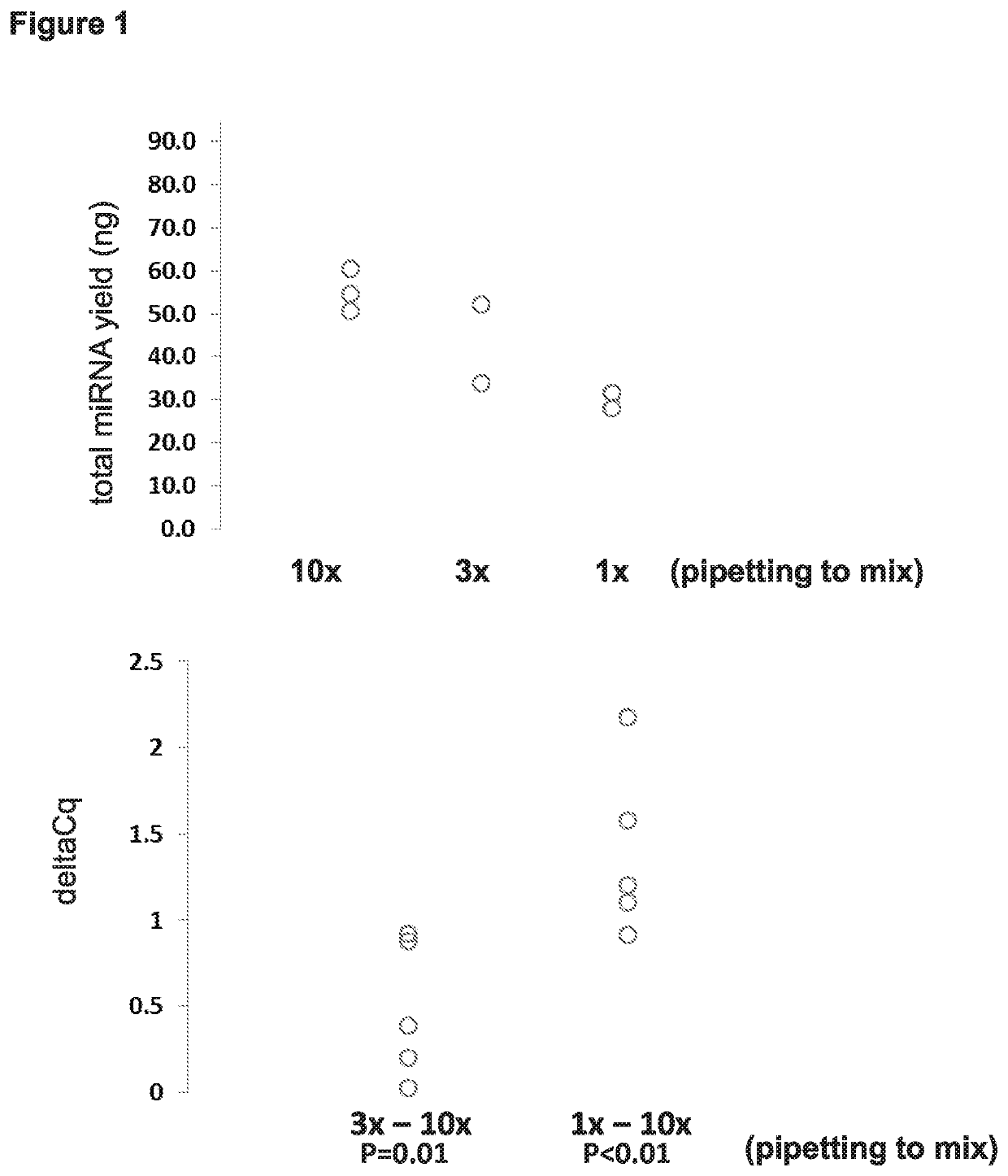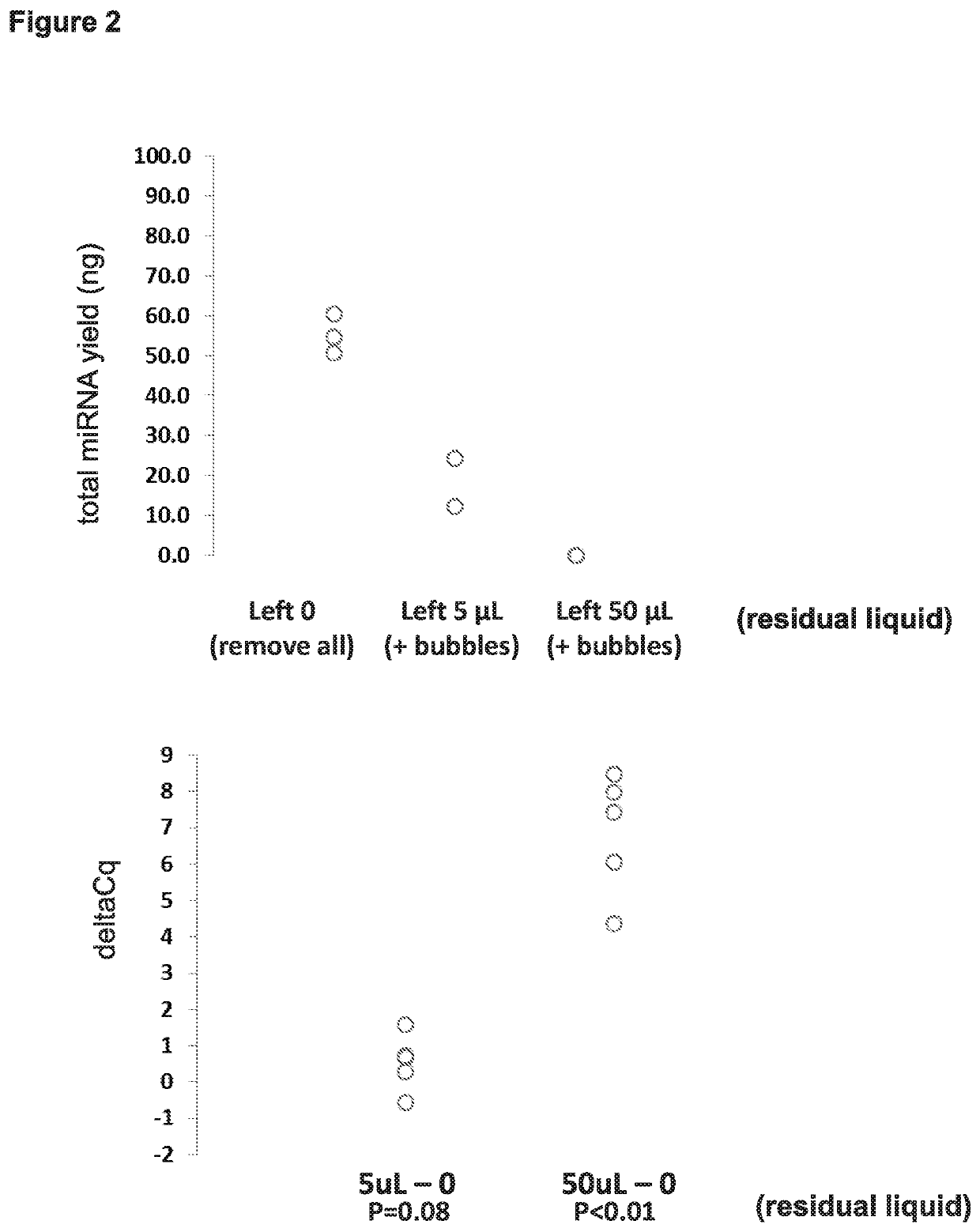Methods and Compositions for Extracting Nucleic Acids Using Ferric Oxide Particles
a technology of ferric oxide particles and compositions, applied in the direction of sugar derivates, organic chemistry, biochemistry apparatus and processes, etc., can solve the problems of dysregulation of the mirna, and achieve the effect of facilitating efficient extraction of nucleic acids
- Summary
- Abstract
- Description
- Claims
- Application Information
AI Technical Summary
Benefits of technology
Problems solved by technology
Method used
Image
Examples
example 1
Parameters: Mixing, Residual Liquid, Elution Volume (FIGS. 1-3)
[0097]Starting with the protocol for DNA extraction depicted on the left side of FIG. 19, various steps were altered with the goal of arriving at improved protocols that allow for efficient extraction of miRNA. As shown in Examples 3 (FIG. 9) and 4 (FIG. 16) below, subject methods for efficient extraction of miRNA can also be used for efficient extraction of mRNA and DNA as well.
[0098]Starting with the protocol for DNA extraction depicted on the left side of FIG. 19, the following were steps were manipulated: (i) removing all residual liquid at steps 5 and 7 versus leaving some residual liquid behind (e.g., 5 μL or 50 μL of residual); (ii) varying the volumes added at steps 8 and 10 (e.g., 10, 20, 30, 40, 50, 100 μL); (iii) removing steps such as using no HPV LBC Diluent, using no proteinase K, or not incubating at steps 1 and 2. miRNA yield was determined using microRNA Quant-it, and miRNA abundance (copies per ng total...
example 2
Parameters: Proteinase K and Others (FIGS. 4-8)
[0143]Various modifications (e.g., amount of proteinase K used, temperature of incubation with proteinase K, and volume of binding buffer) were incorporated into the FOX extraction protocol with the objective of testing whether these modifications could increase yield of miRNA. The Invitrogen Quant-iT RNA Assay Kit was used to quantify total miRNA yield (Each circle represents a technical replicate) and qPCR was used to measure the level of miR-16 (raw Ct values are presented). The data are presented in FIG. 4. In additional to miR-16, four other miRNAs (miR-21, miR-99b, miR-181a, and miR-451a) were also tested, and the improvements to the protocol were reproduced.
[0144]It was then tested whether omitting a boiling step or reducing the binding buffer / Pro K incubation time at 56° C. from 30 to 5 minutes would improve detection of miRNAs (miR-16 value was considered the gold standard and this was compared to delta Ct values for miR-21, mi...
example 4
iently Extract Nucleic Acid (e.g., mRNA and miRNA) from Multiple Different Sample Types (FIGS. 11-16)
[0172]Nucleic acids were successfully extracted from: (i) serum and plasma; (ii) freshly cultured cells (e.g., Human Prostate Cancer (PC3) cells, Androgen-Sensitive Human Prostate Adenocarcinoma (LNCaP) Cells, and Human Colon Tumor (HCT15) cells); (iii) BD SurePath-preserved cells (e.g., HCT15 cells)(e.g., preserved for 7 days); (iv) formalin-fixed paraffin embedded tissue (FFPE)(e.g., archived (5-year) human colon adenocarcinoma samples, and archived human non-small cell lung cancer samples); and (v) whole blood (e.g., collected in BD PAXgene tubes). The amounts of 5 different miRNAs (miR-16, miR-21, miR-99b, miR-181a, and miR-451a) were measured from the samples using qPCR, and the particular miRNAs were chosen because they represent a range of both abundant and rare miRNA in tissue. For the whole blood sample, mRNA was measured from the extracted nucleic acids.
[0173]FIG. 11. Serum...
PUM
| Property | Measurement | Unit |
|---|---|---|
| temperature | aaaaa | aaaaa |
| volume | aaaaa | aaaaa |
| volume | aaaaa | aaaaa |
Abstract
Description
Claims
Application Information
 Login to View More
Login to View More - R&D
- Intellectual Property
- Life Sciences
- Materials
- Tech Scout
- Unparalleled Data Quality
- Higher Quality Content
- 60% Fewer Hallucinations
Browse by: Latest US Patents, China's latest patents, Technical Efficacy Thesaurus, Application Domain, Technology Topic, Popular Technical Reports.
© 2025 PatSnap. All rights reserved.Legal|Privacy policy|Modern Slavery Act Transparency Statement|Sitemap|About US| Contact US: help@patsnap.com



